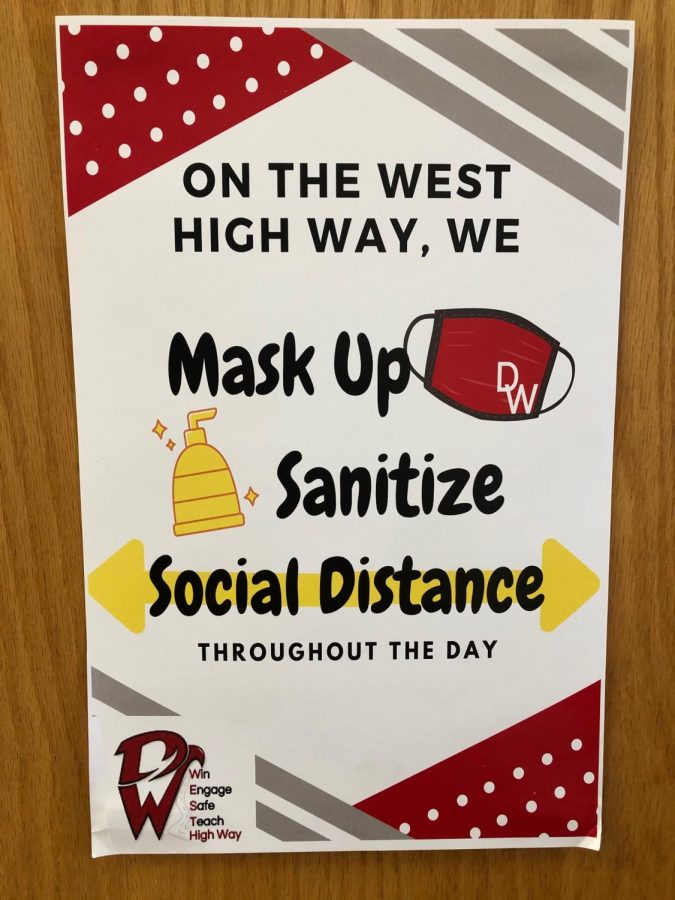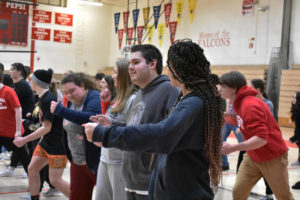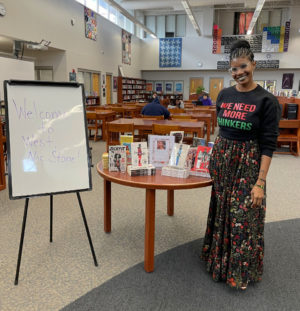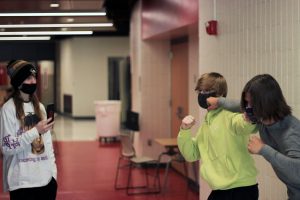A year of change changes again
A shift in learning models causes concern and cheer
In an effort to lower viral spread, posters reminding students to distance and sanitize line the halls.
March 26, 2021
Which mask matches my outfit? Is it an A or B day? During the 2020-21 school year, these are just a few questions students are asking themselves. In a year of uncertainty and change one thing is certain, anything can change on a dime.
On Jan. 12 of 2021, in her State of the State address, Governor Kim Reynolds called on Iowa legislators to pass a bill to require schools to allow parents to send their children to school for 100% in-person learning. This measure was passed Jan. 28 and went into effect Feb.15.
“This bill essentially replaces the hybrid option allowing our students the options of attending school on a 100% full time basis or with 100% online institution” Davenport School Board’s Vice President Linda Hayes said, “For the students of the DCSD, basically you are in school business as usual, with modifications of course, or you continue your studies from home.”
While many celebrate the change of being able to see friends, the sudden alteration comes with a laundry list of things to figure out, like lunches and disinfecting.
“Figuring out how to get lunches to students who purchase lunch is an issue, because there is not good space for them to stand in line and be socially distanced,” Board Member Allison Beck said, “The other issue is time. It just takes longer for cleaning. Desks must be wiped down, and it takes time for disinfectants to work.”
Some of these issues have simple solutions, like how lunch will work.
“Food cannot be distributed cafe-style,” Beck said, “so it will likely have to be pre-packaged or at least pre-portioned.”
While steps have been put into place to slow the spread within the DCSD, a major concern of students, staff, and parents is an increase of cases. As of Mar. 25, Scott County’s 14-day positivity rate is 10% according to the government website titled Covid-19 in Iowa, which is lower than the 21.3% positivity rate on Feb. 5. Despite the positivity rate lowering, the number of cases in children under the age of 18 has risen. As of Feb. 15, there were 36,749 (total) children cases, but in a little over a month, the number has risen to 39,377. An additional 2,628 cases since schools returned 100% in person.
Just because Iowa’s positivity rate is currently low does not mean that it can’t rise again. Especially with the larger class sizes and students returning from spring break.
“Even with 25-30% of our students schooling online, we cannot provide 6 feet of distance between students at all times,” Beck said. “Particularly during passing times and lunch, there will be issues with larger numbers of students in small spaces. Further, eating requires that students remove masks, therefore risk is increased as the highest chance of transmission of Covid-19 occurs through respiratory droplets.”
Without being able to social distance, it is possible that more students will contact Covid-19 or have to quarantine.
“In terms of quarantining we follow the CDC guidelines, and in terms of contact tracing the Scott County Health Department used to do that, and now that is up to our schools,” Superintendent TJ Schneckloth said.“We have a district nurse who is in charge of contact tracing, she finds out the people who were in close contact with the infected person and from there the Scott County Health Department helps notify.”
CDC guidelines constantly change, making it hard to be consistent. Most recently, as of Mar. 19, the CDC lowered the recommended space of social distancing from six feet to three and removed the recommendation for physical barriers (like plastic shields more commonly seen in elementary classrooms).
Schneckloth estimates that one-third of students in the district are online, which certainly helps to keep class sizes smaller and better able to socially distance. But guidelines alone do not stop transmission. In addition to the worries of students missing school, there also comes worries of a teacher and para shortage.
Students missing school is not the only issue, but a lack of teachers and paras.
“There is already a shortage of guest teachers and paras,” Beck said, “and this is just going to make that worse.”
Superintendent Schneckloth explains that there is a plan in place in case the district does run out of substitutes.
“We will work with the Scott County Health Department to determine whether it is safe or not for us to hold school, from there if we fall into that spot we will take action. That might be closing the school until we can have coverage, moving teachers so we can have coverage, or utilizing online learning.”
The district has experienced some relief after being notified that they were approved for federal funding. Beck explained that the federal funding that can help pay for extra PPE and staff hirings, but money can’t fix all.
“We did get federal funding to help alleviate the extra cost that these measures will encumber,” Beck said. “But we have to be judicious about how we spend those dollars and we want to make sure that we do it effectively and efficiently.”
The spread is not the only concern, but also students’ mental health and stress management.
“Students will likely be anxious and nervous about being in this situation, as will their parents,” Beck said. “And when you are concerned about your health or physical well-being, you don’t focus on the learning as well.”
This may not be the case for every student, each student is unique just like their preferred learning style. Regardless, this shift has changed students’ schedules, workload, and social interactions. Some students were excited for this change, like sophomore Lily Shaffer.
“I’m really happy to go back 100% in person,” Shaffer said. “Personally I feel like I learn so much better in person rather than at home.”
But others are a little nervous, like Junior Liz Bixby.
“When I heard we were going 100% in person I was shocked,” Bixby said. “Our [numbers of] cases aren’t going down, so I was confused as to why now and not maybe wait longer.”
Bixby is also concerned with class size in the midst of the pandemic.
“When class sizes increase it obviously is going to make it harder to spread out, my class sizes are big so I plan on switching to the 100% online option, that way I am safe rather than sorry.”
When all was said and done, Bixby said she was impressed with how well teachers enforced things like masks for the first full week back.
“West did a really good job with the conditions they were under. Teachers were great about enforcing masks, even in the hallways.”
But overall Bixby says she preferred the hybrid model and still plans to switch to 100% online learning.
“I just don’t feel safe with how big the class sizes were. With the hybrid option we could social distance.”
On the other hand, Shaffer plans on staying 100% in person.
“I really liked it. I hadn’t realized how much I had missed the feeling of being back to almost normal! I felt like a lot of pressure was taken off as well. Teachers weren’t only focusing on four students.”
Bixby and Shaffer do agree on something, that teachers are doing the best they can in these difficult times.
“I personally feel very comfortable,” Shaffer said. “The teachers were super accommodating and made sure everyone was safe and felt secure.”








